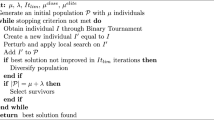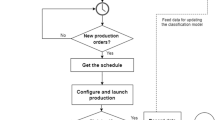Abstract
This paper addresses the Cyclic Jobshop Problem in a flexible context. The flexibility feature means that machines are able to perform several kinds of tasks. Hence, a solution of the scheduling problem does not only concern the starting times of the elementary tasks, but also the assignment of these tasks to a unique machine. The objective considered in this paper is the minimisation of the cycle time of a periodic schedule. We formulate the problem as a Mixed Integer Linear Problem and propose a Benders decomposition method along with a heuristic procedure to speed up the solving of large instances. It consists in reducing the number of machines available for each task. Results of numerical experiments on randomly generated instances show that the MILP modelling has trouble solving difficult instances, while our decomposition method is more efficient for solving such instances. Our heuristic procedure provides good estimates for difficult instances.









Similar content being viewed by others
References
Benders, J. F. (1962). Partitioning procedures for solving mixed-variables programming problems. Numerische Mathematik, 4(1), 238–252.
Błażewicz, J., Domschke, W., & Pesch, E. (1996). The job shop scheduling problem: Conventional and new solution techniques. European Journal of Operational Research, 93(1), 1–33.
Bożejko, W., Gnatowski, A., Klempous, R., Affenzeller, M., Beham, A. (2016). Cyclic scheduling of a robotic cell. In Cognitive Infocommunications (CogInfoCom), 2016 7th IEEE international conference on, IEEE, pp. 000379–000384.
Bożejko, W., Pempera, J., & Wodecki, M. (2017). A fine-grained parallel algorithm for the cyclic flexible job shop problem. Archives of Control Sciences, 27(2), 169–181.
Brucker, P., & Kampmeyer, T. (2008a). Cyclic job shop scheduling problems with blocking. Annals of Operations Research, 159(1), 161–181.
Brucker, P., & Kampmeyer, T. (2008b). A general model for cyclic machine scheduling problems. Discrete Applied Mathematics, 156(13), 2561–2572.
Brucker, P., Burke, E. K., & Groenemeyer, S. (2012). A mixed integer programming model for the cyclic job-shop problem with transportation. Discrete Applied Mathematics, 160(13–14), 1924–1935.
Carlier, J., & Chrétienne, P. (1988). Problèmes d’ordonnancement: modélisation, complexité, algorithmes. Paris: Masson.
Chretienne, P., et al. (1991). The basic cyclic scheduling problem with deadlines. Discrete Applied Mathematics, 30(2–3), 109–123.
Dell’Amico, M., & Trubian, M. (1993). Applying tabu search to the job-shop scheduling problem. Annals of Operations Research, 41(3), 231–252.
Draper, D. L., Jonsson, A. K., Clements, D. P., Joslin, D. E. (1999). Cyclic scheduling. In IJCAI, Citeseer, pp. 1016–1021.
Elmi, A., & Topaloglu, S. (2017). Cyclic job shop robotic cell scheduling problem: Ant colony optimization. Computers & Industrial Engineering, 111, 417–432.
Fink, M., Rahhou, T. B., & Houssin, L. (2012). A new procedure for the cyclic job shop problem. IFAC Proceedings Volumes, 45(6), 69–74.
Gao, J., Sun, L., & Gen, M. (2008). A hybrid genetic and variable neighborhood descent algorithm for flexible job shop scheduling problems. Computers & Operations Research, 35(9), 2892–2907.
Garey, M., & Johnson, D. (1979). Computers and intractability. New York: WII Freeman and Company.
Gomes, M., Barbosa-Povoa, A., & Novais, A. (2005). Optimal scheduling for flexible job shop operation. International Journal of Production Research, 43(11), 2323–2353.
Hamaz, I., Houssin, L., & Cafieri, S. (2018a). A robust basic cyclic scheduling problem. EURO Journal on Computational Optimization, 6(3), 291–313.
Hamaz, I., Houssin, L., & Cafieri, S. (2018b). The Cyclic Job Shop Problem with uncertain processing times. In 16th International conference on project management and scheduling (PMS 2018), Rome, Italy.
Hanen, C. (1994). Study of a NP-hard cyclic scheduling problem: The recurrent job-shop. European Journal of Operational Research, 72(1), 82–101.
Hanen, C., & Munier, A. (1995). A study of the cyclic scheduling problem on parallel processors. Discrete Applied Mathematics, 57(2–3), 167–192.
Hillion, H. P., & Proth, J. M. (1989). Performance evaluation of job-shop systems using timed event-graphs. IEEE Transactions on Automatic Control, 34(1), 3–9.
Houssin, L. (2011). Cyclic jobshop problem and (max, plus) algebra. In World IFAC Congress (IFAC 2011), pp. 2717–2721.
Ioachim, I., & Soumis, F. (1995). Schedule efficiency in a robotic production cell. International Journal of Flexible Manufacturing Systems, 7(1), 5–26.
Jalilvand-Nejad, A., & Fattahi, P. (2015). A mathematical model and genetic algorithm to cyclic flexible job shop scheduling problem. Journal of Intelligent Manufacturing, 26(6), 1085–1098.
Jamili, A., Shafia, M. A., & Tavakkoli-Moghaddam, R. (2011). A hybrid algorithm based on particle swarm optimization and simulated annealing for a periodic job shop scheduling problem. The International Journal of Advanced Manufacturing Technology, 54(1–4), 309–322.
Kampmeyer, T. (2006). Cyclic scheduling problems.
Karp, R. M., & Orlin, J. B. (1981). Parametric shortest path algorithms with an application to cyclic staffing. Discrete Applied Mathematics, 3(1), 37–45.
Kats, V., & Levner, E. (1996). Polynomial algorithms for scheduling of robots. Intelligent Scheduling of Robots and FMS, pp. 77–100.
Kim, H. J., Lee, J. H. (2018). Cyclic robot scheduling for 3D printer-based flexible assembly systems. Annals of Operations Research, pp. 1–21.
Korbaa, O., Camus, H., & Gentina, J. C. (2002). A new cyclic scheduling algorithm for flexible manufacturing systems. International Journal of Flexible Manufacturing Systems, 14(2), 173–187.
Levner, E., & Kats, V. (1998). A parametric critical path problem and an application for cyclic scheduling. Discrete Applied Mathematics, 87(1–3), 149–158.
Magnanti, T. L., & Wong, R. T. (1981). Accelerating benders decomposition: Algorithmic enhancement and model selection criteria. Operations research, 29(3), 464–484.
Papadakos, N. (2008). Practical enhancements to the Magnanti–Wong method. Operations Research Letters, 36(4), 444–449.
Quinton, F., Hamaz, I., & Houssin, L. (2018). Algorithms for the flexible cyclic jobshop problem. In 14th IEEE international conference on automation science and engineering, CASE 2018, Munich, Germany, August 20–24, 2018, pp. 945–950.
Rossi, A., & Dini, G. (2007). Flexible job-shop scheduling with routing flexibility and separable setup times using ant colony optimisation method. Robotics and Computer-Integrated Manufacturing, 23(5), 503–516.
Roundy, R. (1992). Cyclic schedules for job shops with identical jobs. Mathematics of Operations Research, 17(4), 842–865.
Saidi-Mehrabad, M., & Fattahi, P. (2007). Flexible job shop scheduling with tabu search algorithms. The International Journal of Advanced Manufacturing Technology, 32(5–6), 563–570.
Schutten, J. M. (1998). Practical job shop scheduling. Annals of Operations Research, 83, 161–178.
Serafini, P., & Ukovich, W. (1989). A mathematical model for periodic scheduling problems. SIAM Journal on Discrete Mathematics, 2(4), 550–581.
Song, J. S., & Lee, T. E. (1998). Petri net modeling and scheduling for cyclic job shops with blocking. Computers & Industrial Engineering, 34(2), 281–295.
Thomalla, C. S. (2001). Job shop scheduling with alternative process plans. International Journal of Production Economics, 74(1), 125–134.
Xia, W., & Wu, Z. (2005). An effective hybrid optimization approach for multi-objective flexible job-shop scheduling problems. Computers & Industrial Engineering, 48(2), 409–425.
Zhang, H., Collart-Dutilleul, S., & Mesghouni, K. (2015). Cyclic scheduling of flexible job-shop with time window constraints and resource capacity constraints. IFAC-PapersOnLine, 48(3), 816–821.
Author information
Authors and Affiliations
Corresponding author
Additional information
Publisher's Note
Springer Nature remains neutral with regard to jurisdictional claims in published maps and institutional affiliations.
Rights and permissions
About this article
Cite this article
Quinton, F., Hamaz, I. & Houssin, L. A mixed integer linear programming modelling for the flexible cyclic jobshop problem. Ann Oper Res 285, 335–352 (2020). https://doi.org/10.1007/s10479-019-03387-9
Published:
Issue Date:
DOI: https://doi.org/10.1007/s10479-019-03387-9




